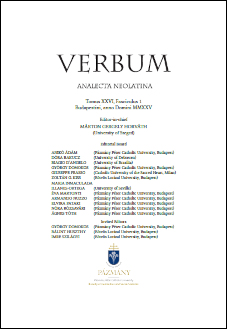Micro-variazione dell’accordo con soggetti post-verbali: Spunti di riflessione sui dati raccolti in due inchieste nel Trentino meridionale
Published 10-07-2025
Keywords
- Northern Italian dialects,
- micro-variation,
- post-verbal subjects,
- data collection methods,
- crowdsourcing
How to Cite

This work is licensed under a Creative Commons Attribution 4.0 International License.
Abstract
This work aims to describe the micro-variation in the sentences with post-verbal subjects in the dialectal varieties of southern Trentino. Like many other northern Italian varieties, the dialects of this area possess subject clitics, which appear in proclitic position in declarative constructions with a pre-verbal third-person subject and usually do not appear in sentences where the subject follows the verb. Thanks to a field survey and an online collection of oral data, it has been possible to observe the micro-variation present in the area, where numerous realizations deviate from the structure described as canonical for verb-subject (VS) order sentences. This work highlights those elements that induce speakers to produce VS constructions with the clitic that realizes verbal agreement. Furthermore, the comparison between the data collected in the two surveys, the field one and the online one, shows that only a high number of data points allows for the capture of aspects that provide a comprehensive view of the phenomenon in question.
References
- AlpiLinK = Il contatto linguistico germanico-romanzo nelle Alpi italiane: documentazione, spiegazione, partecipazione. https://alpilink.it/
- ASIs/ASIt = Atlante sintattico d’Italia (in origine: Atlante Sintattico dell’Italia Settentrionale). http://asit.maldura.unipd.it/
- Belletti, A. (2001): Inversion as Focalization. In: A. Hulk & J. Y. Pollock (eds.) Subject Inversion in Romance and the Theory of Universal Grammar. Oxford: Oxford University Press. 60–90.
- Bianchi, V., G. Bocci & S. Cruschina (2017): Two types of subject inversion in Italian wh-questions. Revue Roumaine de Linguistique 62(3): 233–252.
- Bocci, G. & L. Pozzan (2014). Some questions (and some experimental answers) about Italian subjects: Subject positions in main and embedded questions in L1 and attrition. In: C. Contemori & L. Dal Pozzo (eds.) Inquiries into Linguistic Theory and Language Acquisition. Papers offered to Adriana Belletti. Siena: CISCL Press.
- Brandi, L. & P. Cordin (1989): Two Italian Dialects and the Null Subject Parameter. In: O. Jaeggli & K. Safir (eds.) The Null Subject Parameter. Dordrecht: Kluwer. 111–142.
- Cardinaletti, A. (2001): A Second Thought on Emarginazione: Destressing vs. Right Dislocation. In: G. Cinque. & G. Salvi (eds.) Current Studies in Italian Syntax. Amsterdam: Elsevier. 117–135.
- Cardinaletti, A. (2011): La variazione diatopica delle costruzioni con soggetto di nuova informazione. Studi italiani di linguistica teorica e applicata 40(2): 259–275.
- Cardinaletti, A. (2018): On different types of postverbal subjects in Italian Italian. Journal of Linguistics 30(2): 79–106. DOI: 10.26346/1120-2726-125
- Cardinaletti, A. & L. Repetti (2004): Clitics in northern Italian dialects: phonology, syntax and microvariation. University of Venice Working Papers in Linguistics 14: 7–106.
- Cardinaletti, A. & L. Repetti (2008): The phonology and syntax of preverbal and postverbal subject clitics in Northern Italian dialects. Linguistic Inquiry 39(4): 523–563.
- Casalicchio, J. & P. Cordin (2020): Grammar of Central Trentino. A Romance Dialect from North-East Italy. Leiden & Boston: Brill.
- Cordin, P., S. Rabanus, B. Alber, A. Mattei, J. Casalicchio, A. Tomaselli, E. Bidese & A. Padovan (2018): VinKo. In: T. Krefeld & R. Bauer (eds) Lo spazio comunicativo dell’Italia e delle varietà italiane. Korpus im text. Munich: Ludwig-Maximilians-Universität. www.kit.gwi.uni-muenchen.de/?p=13739&v=2.
- Espinal, M. T. & Villalba, X. (2015): Ambiguity resolution and information structure. The Linguistic Review 32(1): 61–85. https://doi.org/10.1515/tlr-2014-0015
- Keenan, E. (1976): Towards a universal definition of ‘subject’. In: C. Li (ed.) Subject and Topic. New York: Academic Press. 303–334.
- Kruijt, A., P. Cordin & S. Rabanus (2023): On the validity of crowdsourced data. In: E. Pustka, C. Quijada van den Berghe & V. Weiland (eds.). Corpus Dialectology. Amsterdam & Philadelphia: John Benjamins. 10–33. https://doi.org/10.1075/scl.110.01kru
- Leonetti, M. (2017): Basic constituent orders. In: Stark & Dufter (2017: 885–930).
- Leonetti, M. (2018): Two types of postverbal subject. Italian Journal of Linguistics 30(2): 11–36. DOI: 10.26346/1120-2726-122
- Lobo, M. & A. M. Martins (2017): Subjects. In: Stark & Dufter (2017: 27–88).
- Pinto, M. (1994): Subjects in Italian: Distribution and interpretation. In: R. Bok-Bennema & C. Cremers (eds.) Linguistics in the Netherlands. Amsterdam & Philadelphia: John Benjamins. 175–186.
- Rabanus, S., A. Kruijt, M. Tagliani, A. Tomaselli, A. Padovan, B. Alber, P. Cordin, R. Zamparelli & B. M. Vogt (2022): VinKo (Varieties in Contact) Corpus v1.1. Eurac Research CLARIN Centre. http://hdl.handle.net/20.500.12124/46)
- Rizzi, L. (1982): Issues in Italian Syntax. Dordrecht: Foris.
- Samek-Lodovici, V. (2015): The Interaction of Focus, Givenness, and Prosody. A Study of Italian Clause Structure. Oxford: Oxford University Press.
- Seiler, G. (2010): Investigating language in space: Questionnaire and interview. In: P. Auer & J. E. Schmidt (eds) Language and Space. An International Handbook of Linguistic Variation, Vol. 1: Theories and Methods. Berlin: De Gruyter. 512–527.
- Stark, E. & A. Dufter (eds.) (2017). Manual of Romance Morphosyntax and Syntax. Berlin: Mouton De Gruyter.
- Tomaselli, A., A. Kruijt, B. Alber, E. Bidese, J. Casalicchio, P. Cordin, J. Kokkelmans, A. Padovan, S. Rabanus & F. Zuin (2022): AThEME Verona-Trento Corpus. Eurac Research CLARIN Centre. hdl.handle.net/20.500.12124/53.
- Tomaselli, A. & E. Bidese (2023): Fortune and Decay of Lexical Expletives in Germanic and Romance along the Adige River. Languages 8, 44. https://doi.org/10.3390/languages8010044

